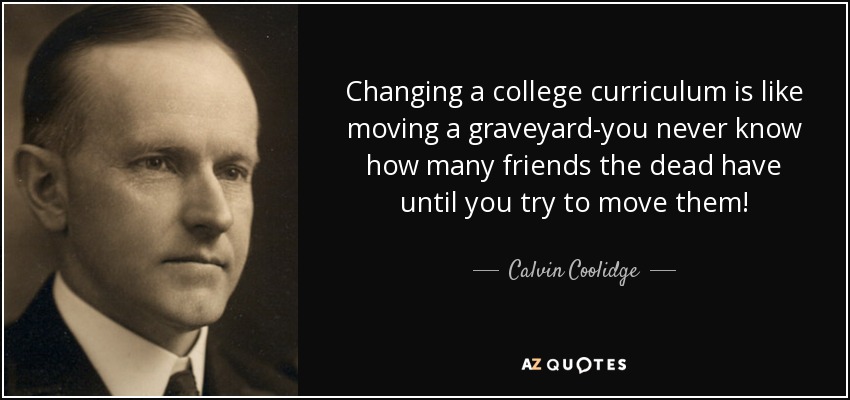If you are not entirely new to higher education research, policy, or practice, chances are you have come across the quote from the title, possibly more than once.
Typically, the analogy between changing universities and moving graveyards is meant to invoke the idea of how unusually, notoriously even, uncooperative universities are when it comes to external pressures to change. It is often drawn by university leaders and policymakers – but not exclusively – as a way to provoke the imagination of their audience or simply to entertain it. Since the analogy resonates rather well with a widely shared understanding of how universities operate, this rhetorical strategy usually works, especially if the audience has not encountered it before.
As it usually goes with all things said or written, unless the person saying or writing something explicitly attributes the message to someone else, the audience may as well credit her or him for being its original author. To see right away how this looks like in practice for the analogy in question, you may want to check out these Twitter search results.
The trouble with this one, however, is that its origin is not so easy to establish. A few minutes spent searching the web and we quickly see various names being credited with it, with a few names appearing more often than others. A closer look at the dates, cross-referencing between sources, and not least at the exact phrasing, suggests potentially multiple careers of the analogy itself. What follows is a brief tour down the history lane.
1. No help from those inside
Probably the most widely shared source was a talk given by Geoffrey Boulton, Vice-Principal of the University of Edinburgh, at a European University Association (EUA) convention in 2009. The talk, titled “What are universities for?”, was cited by several outlets, and was published in full by the University World News, among others. The analogy appears a little later in the text:
The difficulty is, that changing a university is like moving a graveyard, you get no help from the people inside! The temptation to weak rectors or governing boards is to manage this potential anarchy so strongly that all autonomous creativity and diversity of action is squeezed out. We must not fall prey to the fallacy of managerial primacy, that things that make management difficult necessarily need to be removed or reformed.
Boulton did not quote anyone here, which could lead to one concluding that he was the first one to come up with it. Soon after Boulton’s talk at the EUA convention, scholarly pieces quoting “a Vice-Chancellor” saying those words started appearing. For example, in 2010, Tony Bates wrote the following in a chapter of the book Changing Cultures in Higher Education:

We do not know whether the vice-chancellor quoted here was Boulton or someone else. Perhaps even Bates himself did not know. A year later, however, in a book he wrote together with Albert Sangra, Bates used the analogy again, to convey more or less the same message. This time, however, he specified it was a British vice-chancellor who had said that. Boulton’s name was, again, omitted.
As it goes with ideas, Bates’ quote of the quote then got quoted. In his 2018 book Shaping the University of the Future, Stephen Marshall wrote:
Negative stereotyping of faculty is also apparent in the language used by senior leaders. Faculty are often described as a barrier to effective management (Meek & Wood, 1997). Bates (2010, p. 22) quotes one Vice Chancellor as saying ‘Universities are like graveyards. When you want to move them, you don’t get a lot of help from the people inside’.
We find it again in 2019. This time in an article written by Erna Oliver, professor at the University of South Africa, and published in HTS Teologiese Studies/Theological Studies:
At the beginning of the century, Passmore (2000) lamented that it took overhead projectors 40 years to move from bowling alleys to classrooms. The quote by Bates (2010:22) of a vice-chancellor, who said that ‘universities are like graveyards – when you want to move them, you do not get much help from the people inside’, further emphasises two sides of the problem: on the one hand, educators often do not experiment with and implement technology as a helpful tool in educational environments, and on the other hand institutional stakeholders do not create or sustain favourable conditions for innovation and development.
Meanwhile, other variants and attributions of the analogy appeared, which were in no way linked to those we mentioned thus far. For example, in a 2017 article on the digital transformation in higher education published by the news portal Quartz, Wang and Schrager quoted Barb Oakley, a university professor, for saying it:
To be sure, the bulk of people do believe technology is the future of education; they’re just skeptical of the degree to which technology belongs there. “Moving a university is like moving a cemetery—you can’t expect any help from the inhabitants,” says Barb Oakley, a professor who taught traditional class structures at several universities for years before signing up to teach with Coursera as well.
2. A sacrilege
A closer look at what the Internet has to offer on this, however, reveals sources older than the EUA event at which Boulton delivered his talk. Of course, this is not to say that Boulton deliberately appropriated someone else’s idea. He may have thought of it as a piece of common knowledge which didn’t require attribution, maybe even as a truism of some sort. Or maybe he even did come up with it himself.
In 2007, in a footnote on page 60 of his book Financing Public Universities: The Case of Performance Funding, Marcel Herbst was wondering about the same thing. He also came across the analogy in a talk, this time it was by Per Nyborg, at Berkeley back in 2000:

The subject of Nyborg’s talk was the Norwegian contribution to the higher education in the digital age. Yet, as Herbst concludes, Nyborg could have borrowed it from James Q. Wilson’s classic book Bureaucracy: What Government Agencies Do And Why They Do It. Indeed, Wilson did not mention universities specifically; rather, he compared the efforts to change “every social grouping” which acquires certain culture with moving a cemetery:
Every social grouping, whether a neighborhood, a nation, or an organization, acquires a culture; changing its culture is like moving a cemetery: it is always difficult and some believe it is sacrilegious.
It is interesting to note that in Wilson’s view, apart from being a difficult exercise, moving a graveyard is also considered a sacrilege. He didn’t seem worried about not getting any help from those inside, though.
3. It’s conspicuous
Moving a graveyard is also, it turns out, not easily done without drawing much attention to the activity. In 2006, Olaf Jorgenson, then head of school at Almaden Country Day School in San Jose, California, wrote an article titled “Why Curriculum Change Is Difficult and Necessary”. He opened it with the following passage:
A speaker I once heard at a conference on curriculum development compared instructional change to moving graveyards; nobody pays much attention until you try to do it! Years later, after serving in several independent and public schools that collectively embrace a long tradition of academic freedom, this metaphor rings true.
It is noteworthy that, instead of universities, Jorgenson compared changing (school) curriculum with moving graveyards. The explanation he offers is interesting, however. We probably do talk more about urban planning when the bulldozers are on the way, than when no such prospect is in sight. And much like with sacrilege, the problem in trying anything of the sort has much more to do with how the living may react, and not whether the dead are helpful.
4. The dead may have friends
Another version of the analogy revolves around the idea that the dead are not alone and that the living have an interest in what happens to the resting places of their loved ones. Jill Thistlethwaite, the editor of journal The Clinical Teacher, invoked this idea in a 2016 editorial:
As Calvin Coolidge opined: ‘Changing a college curriculum is like moving a graveyard – you never know how many friends the dead have until you try to move them’.
Here Thistlethwaite quotes Calvin Coolidge, the US president 1923-1929. Yet unlike the previously mentioned versions of the analogy, the trouble with moving “the dead” in this case is not that they are unhelpful, or that doing it would be a sacrilege, but that they may have many friends (among the living, I presume).
Provided that Coolidge actually said that, the analogy is at least a century old. Regrettably, whether this happened is a little difficult to verify. The furthest I got with it was this image from AZQuotes:

Although it is not difficult to imagine a politician saying something like this, it seems that Coolidge was also a keen observer of educational affairs, in addition to being the president of the United States. In the biographical work Calvin Coolidge – The Man from Vermont, historian Claude M. Fuess wrote:

Yet even if Coolidge did say it, he may have not been the first one. But if he was, he would probably not be pleased to learn that one of his presidential predecessors is also occasionally credited with saying it, “famously” even:
President Woodrow Wilson famously said, “It is easier to change the location of a cemetery, than to change the school curriculum.” There is no record of why he thought this, though we do not disagree. Indeed the inherited, industrial model of school–married to the agricultural calendar–of the Wilson presidency largely persists despite several revolutions in our world, our technology, and our understanding of learning, human development, and the human brain.
A sub-variant of the analogy – referring to the “medical school curriculum” – seems to have been used by Sir William Osler (1849-1919), a Canadian physician, medical historian, and teacher. According to Robert B. Taylor, the author of Medicine’s Heroes, Heritage, and Misadventures, Osler made important contributions to “medicine’s collections of aphorisms” (pp. 125-128). Our analogy here was, it turns out, among these aphorisms, although it is not entirely clear from this excerpt that Taylor was attributing it to Osler:

Unfortunately, Taylor does not tell us why changing medical curriculum is like moving a graveyard, except that it is difficult. Given the particularly dark nature of this analogy, we should probably not be surprised if it really did originate in the medical field. As Tom Tomlinson, philosophy professor at the Michigan State University noted, “Dark humor of all kinds is very common among medical insiders”.
5. Difficult to destroy
Meanwhile, some have pointed out that the issue with graveyards is not only that they are hard to move, but they are also hard to destroy. The following excerpt from a 1965 article published in the newspapers The Daily Times (“Threats to Higher Education”), penned by Douglas M. Knight, illustrates this:

Indeed, why try?
To conclude this brief “digging” exercise, changing a university is similar to moving a graveyard, for at least five reasons: (1) you won’t get any help from those inside; (2) it’s a sacrilege; (3) it attracts attention; (4) the dead may have many friends; and (5) what you are up against may be ultimately indestructible.
Who did use the analogy first and when? As far as this post is concerned, this remains an open question. Quite certainly, the analogy is not of recent origin. The sources listed here are surely not the whole story of its career(s), probably far from it. Most other instances of its use, which I have found but not included in this post, treat it either as something someone said at a conference, which the author remembered and then decided to use, usually without attribution, or simply as a truism in its own right.
In addition to not being recent or with a single meaning, the analogy is neither exclusive to universities, be it in its semantic applicability or in how it is used, and maybe not even exclusive to educational institutions in general and their practices. After all, and as Wilson noted in the passage cited earlier, the graveyard-like-behavior is something we can expect from any social grouping which “acquires a culture”, and which is then externally pressured to change.
This post was originally published on ECHER Blog.
Photo: A cemetery in Windermere (UK), April 2023. © Jelena Brankovic



